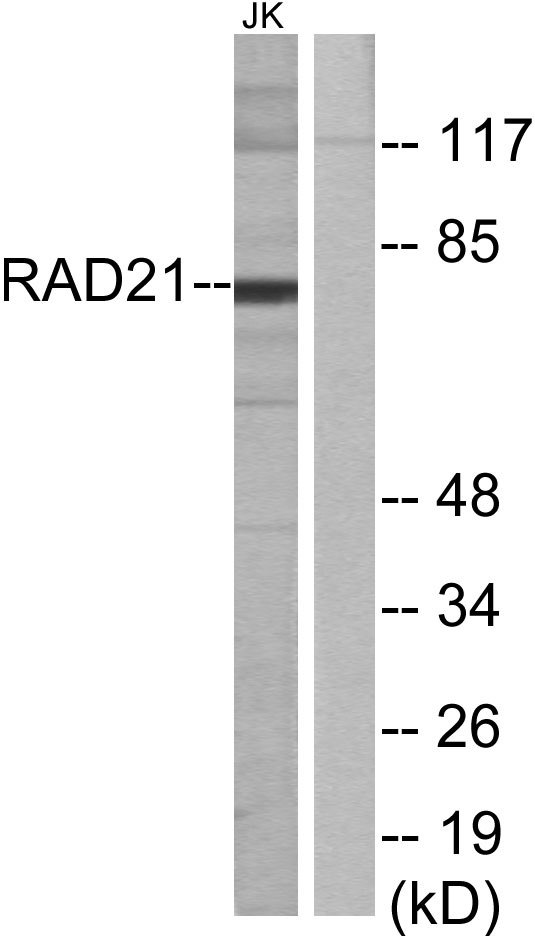产品名称
Rad21 Rabbit Polyclonal Antibody
别名
RAD21; HR21; KIAA0078; NXP1; Double-strand-break repair protein rad21 homolog; hHR21; Nuclear matrix protein 1; NXP-1; SCC1 homolog
蛋白名称
Double-strand-break repair protein rad21 homolog
存储缓冲液
Liquid in PBS containing 50% glycerol, 0.5% BSA and 0.02% New type preservative N.
Human Gene Link
http://www.ncbi.nlm.nih.gov/sites/entrez?db=gene&term=5885
Human Swissprot No.
O60216
Human Swissprot Link
http://www.uniprot.org/uniprotkb/O60216/entry
Mouse Gene Link
http://www.ncbi.nlm.nih.gov/sites/entrez?db=gene&term=19357
Mouse Swissprot No.
Q61550
Mouse Swissprot Link
http://www.uniprot.org/uniprot/Q61550
免疫原
The antiserum was produced against synthesized peptide derived from human RAD21. AA range:521-570
特异性
Rad21 Polyclonal Antibody detects endogenous levels of Rad21 protein.
稀释度
WB 1:500 - 1:2000. IHC 1:100 - 1:300. IF 1:200 - 1:1000. ELISA: 1:5000. Not yet tested in other applications.
宿主
Polyclonal, Rabbit,IgG
背景介绍
The protein encoded by this gene is highly similar to the gene product of Schizosaccharomyces pombe rad21, a gene involved in the repair of DNA double-strand breaks, as well as in chromatid cohesion during mitosis. This protein is a nuclear phospho-protein, which becomes hyperphosphorylated in cell cycle M phase. The highly regulated association of this protein with mitotic chromatin specifically at the centromere region suggests its role in sister chromatid cohesion in mitotic cells. [provided by RefSeq, Jul 2008],
组织表达
Expressed in the gut (at protein level).
细胞定位
[Double-strand-break repair protein rad21 homolog]: Nucleus . Nucleus matrix . Chromosome . Chromosome, centromere . Cytoplasm, cytoskeleton, spindle pole . Associates with chromatin (PubMed:11590136, PubMed:11073952). Before prophase, scattered along chromosome arms (PubMed:11073952). During prophase and prometaphase, most cohesins dissociate from the arms of condensing chromosome, possibly through PLK1-mediated phosphorylation (PubMed:11931760). A small amount of cohesin remains in centromeric regions and is removed from chromosomes only at the onset of anaphase. At anaphase, cleavage by separase/ESPL1 leads to the dissociation of cohesin from chromosomes and chromosome separation (PubMed:11073952, PubMed:11509732). .; [64-kDa C-terminal product]: Cytoplasm, cytosol . Nucleus .
信号通路
Cell_Cycle_G1S;Cell_Cycle_G2M_DNA;
功能
domain:The C-terminal part associates with the head of SMC1A, while the N-terminal part binds to the head of SMC3.,function:Cleavable component of the cohesin complex, involved in chromosome cohesion during cell cycle, in DNA repair, and in apoptosis. The cohesin complex is required for the cohesion of sister chromatids after DNA replication. The cohesin complex apparently forms a large proteinaceous ring within which sister chromatids can be trapped. At metaphase-anaphase transition, this protein is cleaved by separase/ESPL1 and dissociates from chromatin, allowing sister chromatids to segregate. The cohesin complex may also play a role in spindle pole assembly during mitosis. Also plays a role in apoptosis, via its cleavage by caspase-3/CASP3 or caspase-7/CASP7 during early steps of apoptosis: the C-terminal 64 kDa cleavage product may act as a nuclear signal to initiate cytoplasmic events involved in the apoptotic pathway.,polymorphism:Some radiosensitive cancer patients seem to have Arg-481 instead of the conserved Gly-481. It may be that this mutation could contribute to radiosensitivity.,PTM:Cleaved by separase/ESPL1 at the onset of anaphase. Cleaved by caspase-3 and caspase-7 at the beginning of apoptosis. The cleavage by ESPL1 and caspase-3 take place at different sites.,PTM:Phosphorylated; becomes hyperphosphorylated in M phase of cell cycle. The large dissociation of cohesin from chromosome arms during prophase may be partly due to its phosphorylation by PLK.,similarity:Belongs to the rad21 family.,subcellular location:Associates with chromatin. Before prophase it is scattered along chromosome arms. During prophase, most of cohesin complexes dissociate from chromatin probably because of phosphorylation by PLK, except at centromeres, where cohesin complexes remain. At anaphase, it is cleaved by separase/ESPL1, leading to the dissociation of the complex from chromosomes, allowing chromosome separation. Once cleaved by caspase-3, the C-terminal 64 kDa cleavage product translocates to the cytoplasm, where it may trigger apoptosis.,subunit:Cohesin complexes are composed of the SMC1 (SMC1A or SMC1B) and SMC3 heterodimer attached via their hinge domain, RAD21 which link them, and one STAG protein (STAG1, STAG2 or STAG3), which interacts with RAD21. Found in a complex with SMC1A, SMC3, CDCA5, PDS5A/APRIN and PDS5B/SCC-112.,
纯化
The antibody was affinity-purified from rabbit antiserum by affinity-chromatography using epitope-specific immunogen.

